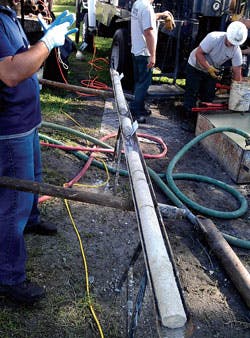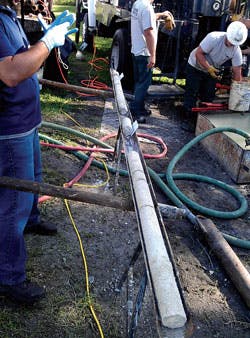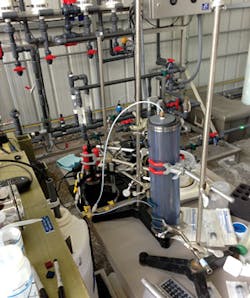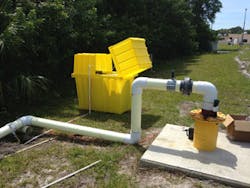By Jeffrey M. Trommer
Since the 1920s, the city of Clearwater, Fla., has utilized groundwater as a source of potable water supply. The city currently produces approximately 50 percent of its own potable water to supply its 11 million gallons per day (MGD) demand.
Groundwater for potable supply is withdrawn from the Upper Floridan aquifer, which has limited local recharge and is underlain at relatively shallow depth by more saline water due to the influence of the adjacent saltwater bodies. The withdrawal of additional groundwater is therefore limited by the potential for both upward and lateral migration of more saline water.
Clearwater operates its own wastewater system and produces high-quality reclaimed water for reuse. In order to maximize the beneficial use of its reclaimed water and improve water levels within the area of its well fields, the city is continuing a project to purify reclaimed water and use the purified water to replenish the Upper Floridan aquifer with a 3-MGD groundwater replenishment system.
The purification plant and recharge well system will be constructed on city property containing the Northeast Water Reclamation Facility (NEWRF) and adjacent golf courses. The project is co-funded by the Southwest Florida Water Management District (SWFWMD).
Feasibility studies for the project have been completed that addressed: 1) hydrogeologic aspects of direct aquifer recharge; 2) technologies for treating the water to drinking water standards, including removal of microconstituents, viruses, pharmaceuticals, and low-molecular-weight organics; and 3) post-treatment of the treated water for compatibility with the aquifer water and rock matrix, as well as prevention of metals mobilization.
The feasibility studies indicated that the local hydrogeology is suitable for direct aquifer recharge and that the treatment technologies are available to cost-effectively treat the reclaimed water to the standards required for direct aquifer recharge.
Hydrogeologic Evaluation
The geology of the area consists in general of a layer of unconsolidated sand, silt and clayey-sand underlain by a sandy-clay to clay layer. The clay layer is underlain by a limestone sequence comprised of, in descending order, the Tampa Member and Suwannee Limestone. The surficial sand layer is 10-feet thick at the site and is underlain by 20 to 40 feet of silty to sandy clay.
The sandy-clay layer overlies the Tampa Member limestone. The Tampa Member occurs from 50 to 230 feet below land surface (BLS) at the site and unconformably overlies the Oligocene age Suwannee Limestone. The top of the Suwannee Limestone is at a depth of approximately 230 feet BLS, The Suwannee Limestone is approximately 280-feet thick at the site.
The Upper Floridian aquifer in Pinellas County is divided into three permeable zones separated by semi-confining units. The zones are alphabetically labeled with increasing depth from A to C. Zone A comprises the Tampa Member and the uppermost part of the Suwannee Limestone and is the shallowest and freshest of the producing zones. It is typically separated into upper Zone A and lower Zone A in Pinellas County.
Upper Zone A is comprised of the Tampa Member and is the primary source for water supply in the north Pinellas County area, including the city of Clearwater's supply wells. This zone is present from 40 to 180 feet BLS at the site, and total dissolved solids (TDS) concentration is less than 500 mg/L. Further, Lower Zone A occurs in the upper part of the Suwannee Limestone and is present from 230 to 330 feet BLS. TDS concentration here increases with depth from 600 to 1,200 mg/L.
Direct Aquifer Recharge
The concept of direct aquifer recharge for this project is to inject the purified water into lower Zone A of the Upper Floridan aquifer. The water will migrate laterally through lower Zone A and slowly upward into upper Zone A. The effect of the recharge is to increase aquifer levels up-gradient of the city's supply wells and reduce the amount of drawdown induced by the well field.
The current phase of the project includes site-specific hydrogeologic testing being performed by Leggette, Brashears & Graham (LBG), along with a one-year operation of a pilot treatment plant designed by Tetra Tech. The hydrogeologic evaluation consisted of permitting, construction and testing of a Class V test recharge well and four associated monitoring wells. Rock cores were collected from the recharge zone to use for arsenic leaching analyses using water from various stages of the pilot treatment system.
The one-year test of the pilot water purification treatment system is nearing completion, and a six-month recharge test using a fluoride tracer is currently underway. And aquifer test results indicated that the transmissivity of lower Zone A is approximately 14,000 ft2/day, which is suitable for groundwater recharge.
Mobilization of metals, primarily arsenic, has posed a problem for aquifer storage and recovery (ASR) projects in Florida. As part of evaluating the potential for metals mobilization for this project, rock cores were collected from the recharge zone to perform metals leaching tests and mineralogical analyses (see Fig. 1). Continuous cores were collected from 230 to 330 feet BLS. Core sections to be used for the leaching analysis were transferred to sealed preservation tubes, where the air was vacuum-extracted and replaced with nitrogen to maintain the cores in an anoxic environment.
The preserved cores were subsequently used in column tests for metals leachability (see Fig. 2). Core sections approximately one foot long were emplaced in columns where water from the pilot treatment plant was run through the core and sampled on the output end at timed intervals for water quality analysis. Column tests were run with water from various stages of the treatment process including various degrees of dissolved oxygen (DO) removal. Final results of this analysis are not available as of this abstract.
The final element of the hydrogeologic evaluation is the performance of a six-month recharge test to evaluate aquifer response to injection and to collect data to update the MODPATH model for travel time analysis. Groundwater from a remote supply well was piped to the test recharge well and injected at 300 gallons per minute (GPM). A fluoride feed was also added to the water use as a groundwater tracer (see Fig. 3).
Water samples are being collected weekly from the four monitoring wells for analysis of water quality parameters. Water levels are being recorded in the recharge wells and monitoring wells. The test began in early April and will continue through September. As of this abstract, the fluoride tracer has not been identified at the monitoring wells.
Groundwater modeling including a MODFLOW groundwater flow and associated MODPATH particle tracking model were prepared during the feasibility study. The flow model was used to evaluate the reduction in drawdown from the city's supply well field. The results indicated that between 0.5 and 1 foot of potentiometric surface rise could be achieved across the well field.
The particle tracking model was performed to estimate travel time of the injected water, specifically to demonstrate that this time to the nearest supply well was greater than six months. The initial model results showed that injected water took approximately one year to leave the city-owned project site. Data from the six-month recharge test is currently being used to update and refine the groundwater flow and particle tracking models.
Water Purification System
The water purification system is a three-step multiple-barrier process. First, ultrafiltration removes suspended solids and microorganisms. Reverse osmosis (RO) then removes bacteria, some viruses, metals, inorganics, organics, and pharmaceuticals. Lastly, an advanced oxidation process (AOP) using hydrogen peroxide and ultraviolet (UV) light removes viruses and low-molecular-weight organics such as N-nitrosodimethylamine (NDMA).
A one-year pilot test of the purification process was recently completed. Reclaimed water from the NEWRF was used in a 25-GPM on-site pilot plant to demonstrate the effectiveness of purifying reclaimed water.
An extensive sampling and analysis program was implemented to demonstrate that the aforementioned constituents could be successfully and reliably removed and that the system could be operated and maintained in a manner that will be reliable and cost-effective at full scale. The results of the pilot test indicated that:
- The system meets organics removal requirements for total organic carbon and total organic halides.
- Microorganisms including coliforms, cryptosporidium, viruses, giardia, and helminthes were effectively removed.
- Haloacetic acids and total trihalomethanes were effectively removed.
- Of the 28 out of 175 microconstituents found in the reclaimed (influent) water, only one analyte -- atenolol -- was detectable in the finished water.
- Spike testing of the AOP showed that it meets California Department of Public Health (CDPH) draft guidelines for removal of 1,4-dioxane and NDMA.
- Mutagenicity tests showed that the water did not have mutagenic effects.
The other key aspect of the purification process is post-treatment of the purified water to remove DO and make the water chemistry compatible with the native aquifer water and rock matrix. Membrane contactors were used to effectively remove the 3.5 log of DO to below 10 parts per billion (ppb). Carbon dioxide and calcium were added to balance pH and alkalinity, and sodium bisulfide was added to quench residual hydrogen peroxide from the AOP and reduce the oxidizing reduction potential (ORP) of the water.
The results of the hydrogeologic testing and the one-year pilot treatment plant test indicate that the project is technically feasible for full design and construction. A comprehensive public outreach program is being implemented as part of a project to inform the technical community, public officials and the general public of the steps involved in this testing and evaluation. Public feedback has been very favorable.
Preparation of final hydrogeologic and pilot treatment test reports is currently underway. Costs estimates are being revised, and the project is under consideration to be funded for final design, permitting and construction. Design and permitting is scheduled for completion in 2015, with construction planned to begin in 2016.
About the Author: Jeffrey Trommer is a senior associate with LBG in Tampa, Fla., and serves as the primary hydrogeologist for the city of Clearwater's groundwater replenishment project. A Florida Licensed Professional Geologist, he has a BS in Geology from the University of Wisconsin–Milwaukee and an MS in Geology from the University of South Florida. He has 28 years of experience in hydrogeologic investigations, specializing in water supply development, water use permitting, injection well permitting, construction, and testing, effluent disposal and reuse, groundwater modeling, and regional groundwater resource evaluations.
More WaterWorld Current Issue Articles
More WaterWorld Archives Issue Articles






